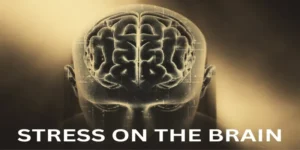Have you ever experienced a shortage of breath? Or the feeling as if your heart is pounding harder than a train on a track? These could be the after-effects of a heavy workout, but what if you experience these symptoms at night or during the ordinary day? If you have experienced something like this, you could have undergone an anxiety or panic attack episode.
Panic attacks can seem highly similar to a heart attack, which makes the person having them even more scared while having it. But if it’s not a heart attack, what is happening in the body that causes a panic attack?
Difference Between a Heart Attack and Panic Attack
Unlike a heart attack which is caused due to blockage of the coronary arteries, a panic attack is triggered by stress or fear. A panic attack is caused when the Amygdala senses danger and sends a message to the sympathetic nervous system; this releases adrenaline – creating physiological symptoms as if there is a life & death situation in front of the person.
Thus, a person gets into a ‘fight or flight’ mode, which one experiences when facing any physical threat. The heart starts pumping blood in full force to all organs; hands get sweaty, and a strange feeling of fear creeps in, but the person is unable to comprehend why this is happening. Thereby, a person ends up fearing even more & falling prey to the symptoms more often as time goes on.
Our Wellness Programs
Information About Panic Attacks
Now you may think, what could one fear when fast asleep that can cause a panic attack in the middle of the night or a similar situation? While the valid reasons for the panic attack might be unknown, it is believed that certain conditions can trigger memories of trauma in the past that can cause such a form of trauma. Panic attacks are also common in several anxiety disorders like Post Traumatic Stress Disorder, Obsessive Compulsive Disorder, Anxiety Disorder or Social Anxiety Disorder. If untreated in the early stages, this can lead to Panic disorder which is caused due to stress regarding panic attacks & even behavioural changes.
The data collected by researchers shows that an estimated 10 in every 100000 people in India have a panic attack. According to the Canadian Mental Health Association, a third of the adult population may suffer from panic attacks in any given year.
Looking for services related to this subject? Get in touch with these experts today!!
Experts

Kirti Bajpai

India
Psychologist
Experience: 5 years

Mansi Chawla

India
Psychologist
Experience: 12 years

Sapna Zarwal

India
Psychologist
Experience: 19 years
Treatment for Panic Attacks
Panic Disorder can be treated with anti-depressants or cognitive behavioural therapy with a 40% chance of recovery. While anti-depressants are administered, in severe cases, CBT has a long-term positive impact in overcoming or controlling anxiety disorder.
During CBT, a therapist helps identify the causes or thoughts that lead to the panic attack. The therapist then helps the patient by teaching them techniques to calm panic attacks. The therapist also helps with cognitive restructuring, which means that they identify the common thought that engulfs you during a panic attack. Ideas such as: “I have a heart attack” or “I am going to die”. The therapist then restructures these thoughts replacing these with scary thoughts with more positive reviews. The next phase is introducing & understanding the situations which act as triggers causing the panic attack, revisiting them and instilling a belief that the problem isn’t as scary as it seems.
How to Help Someone Having a Panic Attack
While visiting a behavioural therapist for containing panic attacks should be on top of your list if someone close to you is experiencing a panic attack; you’ll find some methods on how to deal with panic attacks.
1. Observe & Identify
A heart attack & panic attack might seem the same. So, to rule out a heart attack, you need to ensure that the person is not experiencing any chest pain along with breathlessness & a pacing heart. A panic attack usually settles within 20 minutes, but a heart attack can last longer.
2. Keep Calm
When you’re calm, you can think more clearly and become more dependable for the person who’s having a panic attack. You can make the right decisions for the person having an attack with a calm mind & just being present.
3. Don’t Make Assumptions, Ask.
Ask what the person needs. Ask what they need to maintain their calmness in a new situation and be available for them if anything is triggering around for that person.
4. Speak in Short, Simple Sentences
Understand that the person having a panic attack cannot talk much and explain things. So try speaking simple sentences like: “Tell me what you need now.”, “What you feel is scary, but it is not dangerous.” “I am here; you are safe.”
5. Help with Breathing Exercises
Help the person by breathing with them. Count slowly till ten and go breath by breath with them. This will help them slow their racing heart and breathing.
How to Calm a Panic Attack
But if you do not have anyone around while you undergo a panic attack, here are a few breathing exercises that can help you calm down during an episode.
1. Take Slow, Deep Breaths
i. When you feel your breath is out of control, focus on each inhale and exhale.
ii. Feel your stomach fill with air as you inhale.
iii. Then, count to 4 as you exhale.
iv. Repeat this until your breath slows down.
2. Focus Your Attention on a Single Object
During a panic attack, it sometimes helps to focus all your attention on a single object. Note all its minor attributes– size, colour, and shape.
3. Try Closing Your Eyes
During a panic attack, it might help to close your eyes.
4. Do Some Light Exercise
When you walk to do some light exercise, your body releases endorphins, which relaxes and lightens up your mood.
5. Picture Your ‘Comfortable Place.’
When undergoing a panic attack, it can help to picture a place you feel most comfortable in. It can be a beach, near a fireplace or in the presence of someone close to you, and this place should make you feel comfortable, safe and relaxed.
How to Prevent Panic Attacks
The best way to prevent panic attacks is to perform slow diaphragmatic breathing. This exercise is used to avoid attacks, and this should not be used while a person is having a seizure. Here are the steps:
1. Sit comfortably in a chair with your feet on the floor.
2. Fold your hands on your belly.
3. Breathe slowly and calmly.
4. Fill up the belly with normal breath. Try not to breathe in too heavily. The hands should move up when you live as if you are filling up a balloon.
5. Avoid lifting the shoulders as you inhale; breathe into the stomach.
6. Breathe out slowly to the count of “5.”
7. Try to slow down the rate of the exhale.
8. After the exhale, hold for 2-3 seconds before inhaling again.
9. Work to continue to slow down the pace of the breath.
10. Practice this for about 10 minutes.
Guided Meditation for Panic Attacks
If you want to hear an expert take you through breathing, click on the link for a meditation technique for panic attacks.
Panic Disorder Counseling and Panic Attack Therapy
Panic attacks can be frightening to experience regularly, and recurring panic attacks can result in a condition known as panic disorder. If not treated, panic disorder symptoms can significantly impact daily activities and make it challenging to lead a happy life. United We Care offers therapy for panic attacks, improving lives significantly. Talk to a therapist today by checking out our psychotherapy counselling services.
















